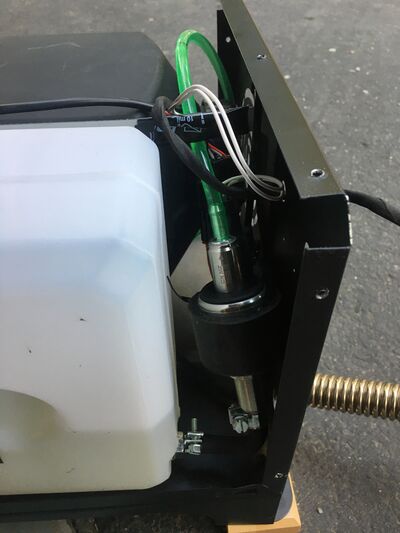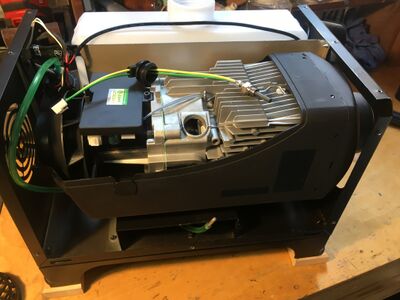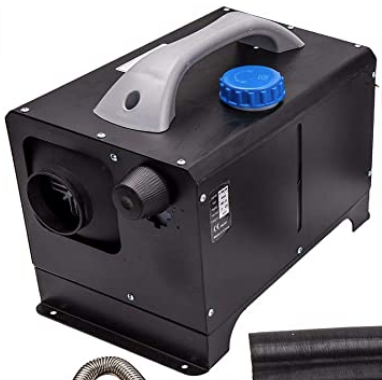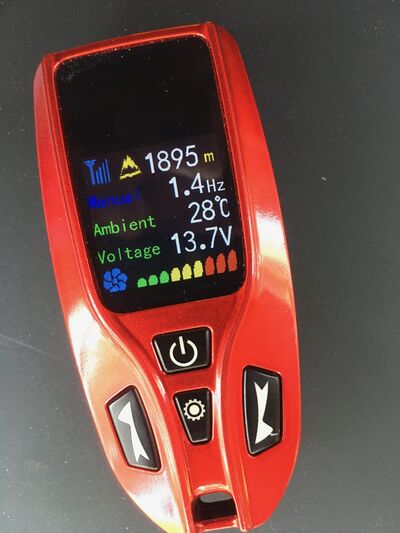Difference between revisions of "Diesel Cabin Heater - Portable"
| Line 1: | Line 1: | ||
| − | Diesel heaters (eg. Eberspacher, Espar or Webasto) have typically run about $2k +/- how much the extras cost | + | Diesel heaters (eg. Eberspacher, Espar or Webasto) have typically run about $2k +/- depending on how much the extras cost. Chinese knock-off copies are coming in from $100-$200 USD complete with graphic displays and remote control, along with a basic exhaust pipe/muffler setup. |
I picked up an all-in-one 8 kilowatt unit (real world: 5k) complete with 5L tank and fuel pump that's about the size of a medium toolbox and weights about 20lbs. The setup will be running on the deck midship, outside an opening port, set athwartship to pump in fresh/dry/warmed air while keeping the exhaust & any noise outside. | I picked up an all-in-one 8 kilowatt unit (real world: 5k) complete with 5L tank and fuel pump that's about the size of a medium toolbox and weights about 20lbs. The setup will be running on the deck midship, outside an opening port, set athwartship to pump in fresh/dry/warmed air while keeping the exhaust & any noise outside. | ||
| − | While the self-contained heaters in these units seem very similar to the german made units the sellers often use lower quality accessories including stiff exhaust pipe and in my unit | + | While the self-contained heaters in these units seem very similar to the german made units the sellers often use lower quality accessories including stiff exhaust pipe and in my unit a fuel line that needed to be upgraded as these unit are very sensitive to proper fuel delivery. I wound up swapping out the 4mm ID flexible fuel hose as it caused the unit to burn with quite a bit of soot. With a proper 2mm OD (4mm OD) hard nylon fuel line - joined with small sections of rubber fuel line - and a small fuel filter, the unit burned cleanly w/o soot or any odor. (Why so critical? See YT expert John McK: https://www.youtube.com/watch?v=jCZhjGyR3bo) |
| − | It should easily fit into the cockpit locker and on medium to low I should be able to get at least two nights (24-30hrs on low, 12+hrs on high) from the 5L tank. | + | It should easily fit into the cockpit locker and in use on medium to low I should be able to get at least two nights (24-30hrs on low, 12+hrs on high) from the 5L tank. |
| − | I also added a 12 foot 14AWG extension coord w/ a cigarette lighter plug for power. The unit uses around 9 amps on startup/shutdown but only for maybe a minute or two and then backs off to < 1 amp on low maybe 2 amps on max. | + | I also added a 12 foot 14AWG extension coord w/ a cigarette lighter plug for power. The unit uses around 9 amps on startup/shutdown but only for maybe a minute or two and then backs off to < 1 amp on low, maybe 2 amps on max. |
While there are many controller options out there the unit I purchased came with a color remote that displays the battery voltage, altitude, ambient temperature | While there are many controller options out there the unit I purchased came with a color remote that displays the battery voltage, altitude, ambient temperature | ||
| − | measured in the receiving unit which looks like a black knob mounted on the front. I have attached | + | measured in the receiving unit which looks like a black knob mounted on the front. I have attached the receiver with velcro as I plan to drop it into the cabin along side the vent duct as there's an extra foot or so of cable attached to it. While the unit will track cabin temperature the remote also lets you manually control the fuel pump rate from 1.4hz to 5.5hz (each stroke of the pump delivers approx 0.00002 liters). |
[[File:Heater.png|600px]][[File:Remote.jpg|400px]] | [[File:Heater.png|600px]][[File:Remote.jpg|400px]] | ||
| Line 28: | Line 28: | ||
Once I get to see my boat again I'll test onboard and upload a few more photos but so far testing outside at night it's been great and with the new fuel hose it burns impressively clean once it's up to temperature, no smell of burnt diesel at all and little to no soot build up in the exhaust pipe. On that note I'm told that some people after running all night on low will run the unit on high for 5-10 minutes to clean/burn out any soot that might have built up. | Once I get to see my boat again I'll test onboard and upload a few more photos but so far testing outside at night it's been great and with the new fuel hose it burns impressively clean once it's up to temperature, no smell of burnt diesel at all and little to no soot build up in the exhaust pipe. On that note I'm told that some people after running all night on low will run the unit on high for 5-10 minutes to clean/burn out any soot that might have built up. | ||
| − | You can also buy these units ready to install onboard but I would definitely order a proper exhaust and well sealed muffler and be prepared to spend another $100-$200 for thru hull fitting ($60) | + | You can also buy these units ready to install onboard but I would definitely order a proper exhaust and a well sealed muffler and be prepared to spend another $100-$200 for thru hull fitting ($60) and marine grade exhaust and ducting - imagining how nice it could be extending the sailing season with warm air pouring out of the cabin underway - it sure has been nice with my engine driven heater while motoring on those cold/foggy mornings. |
Revision as of 03:05, 30 August 2020
Diesel heaters (eg. Eberspacher, Espar or Webasto) have typically run about $2k +/- depending on how much the extras cost. Chinese knock-off copies are coming in from $100-$200 USD complete with graphic displays and remote control, along with a basic exhaust pipe/muffler setup.
I picked up an all-in-one 8 kilowatt unit (real world: 5k) complete with 5L tank and fuel pump that's about the size of a medium toolbox and weights about 20lbs. The setup will be running on the deck midship, outside an opening port, set athwartship to pump in fresh/dry/warmed air while keeping the exhaust & any noise outside.
While the self-contained heaters in these units seem very similar to the german made units the sellers often use lower quality accessories including stiff exhaust pipe and in my unit a fuel line that needed to be upgraded as these unit are very sensitive to proper fuel delivery. I wound up swapping out the 4mm ID flexible fuel hose as it caused the unit to burn with quite a bit of soot. With a proper 2mm OD (4mm OD) hard nylon fuel line - joined with small sections of rubber fuel line - and a small fuel filter, the unit burned cleanly w/o soot or any odor. (Why so critical? See YT expert John McK: https://www.youtube.com/watch?v=jCZhjGyR3bo)
It should easily fit into the cockpit locker and in use on medium to low I should be able to get at least two nights (24-30hrs on low, 12+hrs on high) from the 5L tank.
I also added a 12 foot 14AWG extension coord w/ a cigarette lighter plug for power. The unit uses around 9 amps on startup/shutdown but only for maybe a minute or two and then backs off to < 1 amp on low, maybe 2 amps on max.
While there are many controller options out there the unit I purchased came with a color remote that displays the battery voltage, altitude, ambient temperature measured in the receiving unit which looks like a black knob mounted on the front. I have attached the receiver with velcro as I plan to drop it into the cabin along side the vent duct as there's an extra foot or so of cable attached to it. While the unit will track cabin temperature the remote also lets you manually control the fuel pump rate from 1.4hz to 5.5hz (each stroke of the pump delivers approx 0.00002 liters).
Self contained, just add diesel and 12 volts: Dimension in inches - 10W x 15L x 12H


Original 4mm green fuel line required upgrading to 2mm nylon - key for a clean burn.

I had some trouble with the original glow plug but after replacing with a new $15 one from ebay it's been fine. For the price it's easy to handle a few bumps. The computer controller on the unit has a range of error codes to help diagnose issues & and protect from over heating or other safety considerations.
Once I get to see my boat again I'll test onboard and upload a few more photos but so far testing outside at night it's been great and with the new fuel hose it burns impressively clean once it's up to temperature, no smell of burnt diesel at all and little to no soot build up in the exhaust pipe. On that note I'm told that some people after running all night on low will run the unit on high for 5-10 minutes to clean/burn out any soot that might have built up.
You can also buy these units ready to install onboard but I would definitely order a proper exhaust and a well sealed muffler and be prepared to spend another $100-$200 for thru hull fitting ($60) and marine grade exhaust and ducting - imagining how nice it could be extending the sailing season with warm air pouring out of the cabin underway - it sure has been nice with my engine driven heater while motoring on those cold/foggy mornings.

